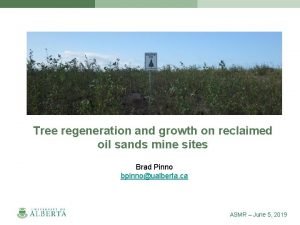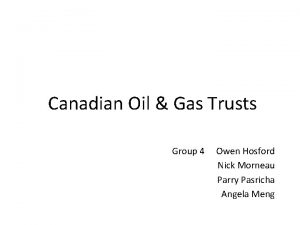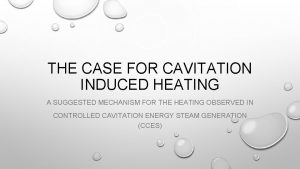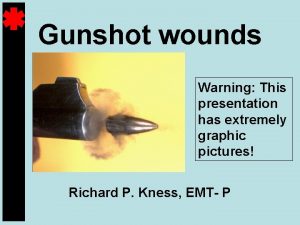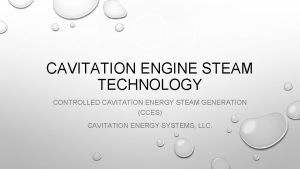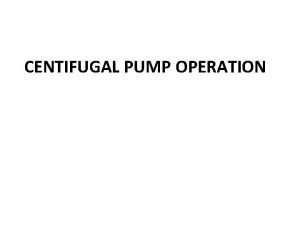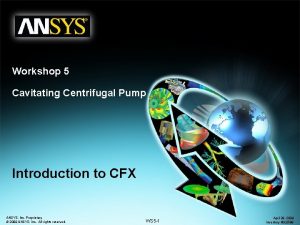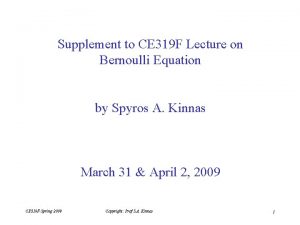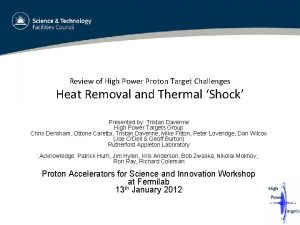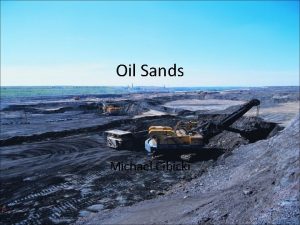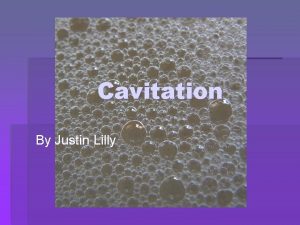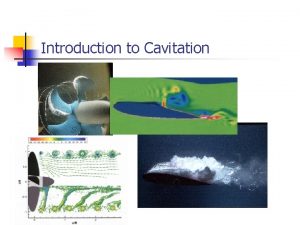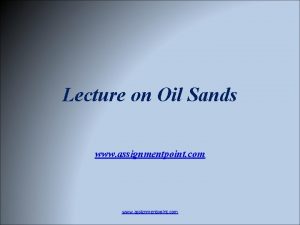Cavitation Technology Development for Oil Sands Processing Deepak














- Slides: 14

Cavitation Technology Development for Oil Sands Processing Deepak M. Kirpalani and Nishi Bhatt Energy Mining and Environment Portfolio –NRC Canada August 2012 Presented at the 8 th International Symposium on Cavitation - CAV 2012

Cavitation Studies at NRCC High Speed Imaging of Cavitation Bubbles Laser Interferometry of Acoustic Cavitation Phase Field Modeling of Cavity Under Shear Presented at the 8 th International Symposium on Cavitation - CAV 2012

Oil sands are unconventional heavy oil deposits composed of water 4 -6%, sand, clay and bitumen (12%) and other minerals. Mineral matter -80 -85% Extraction technology: Mined Oil sands Crushed &Screened mixed with hot water in cyclofeeder to 50 -55 deg. C Pumped (hydrotransported) separation vessels where bitumen froth (60% bitumen, 30% water, 10% fines) floats on the surface. Processing Issues: pumping costs and sand erosion Tailings Requirements: Energy Resource Control Board of Alberta, Canada Directive ‑ 074 requires that the oil sands industry minimize and eventually eliminate long-term storage of fluid tailings in the reclamation landscape. Commercial Thickeners are currently used. Presented at the 8 th International Symposium on Cavitation - CAV 2012

Acoustic Cavitation for Bitumen Extraction • Early stage research (Sadeghi, 1990) showed that acoustic cavitation at 40 KHz. can be applied for extracting bitumen from oil sands. • The reaction rate was further enhanced by the addition of H 20 2. Benefits: 1. Eliminates the need for surfactants or alkaline chemical agents during extraction 2. Circumvents hot water and steam use Presented at the 8 th International Symposium on Cavitation - CAV 2012

Cavitation Benefits to Oil Sands Processing Homogenization of Liquids Emulsion preparation Breakage of solid particles Suspension Preparation Radicalization of Molecules Depolymerization, Lyzing, Reaction Local temp change and availability of free radicals Acceleration of chemical conversion Presented at the 8 th International Symposium on Cavitation - CAV 2012

Research Focus 1. Determine viscosity changes on model rheological fluids by applying acoustic cavitation methods using a broad spectrum transducer 2. Perform Cavitation Yield Measurements to determine the effect of change in Acoustic Frequency and Power on Chemical Conversion using a single broad spectrum transducer. Presented at the 8 th International Symposium on Cavitation - CAV 2012

Experimental Setup for Acoustic Cavitation Ultrasonic waves were generated at 378, 574, 850, and 1125 k. Hz using a broad spectrum transducer for a solution volume of 200 ml held within a jacketed glass water cooled column. Laboratory experiments were performed (1) to determine viscosity changes with a CMC-Water 0. 7 wt % mixture at 1000 c. P at 2. 5 RPM and (2) Cavitation yield determination with 0. 1 and 1% (wt) KI solution. Presented at the 8 th International Symposium on Cavitation - CAV 2012

Visualization of 850 KHz. Sonication at high frequencies (850 Khz. and above), leads to the formation of a fountain jet at the surface of the liquid, releasing droplets from the surface of the jet. Sonication Frequency Jet Diameter Jet Height 850 KHz. 3 cm. 1. 125 MHz. 1. 5 cm. 4 cm. Presented at the 8 th International Symposium on Cavitation - CAV 2012

Results –Change in Viscosity as a function of Sonication Time 120 Viscosity change/ Initial viscosity vs. experiment duration 100 1173 k. Hz V / V 0 (%) 80 850 k. Hz 60 574 k. Hz 378 k. Hz 40 20 0 0 20 40 60 80 Time (min) 100 120 140 Change in viscosity for 0. 7 wt% CMC-water mixture over a range of sonication frequencies Presented at the 8 th International Symposium on Cavitation - CAV 2012

Results - Cavitation Yield Measurements Absorbance vs. Iodine Concentration Absorbance 0. 5 378 k. Hz 574 k. Hz 850 k. Hz 1125 k. Hz 0 20 Time (min) 40 60 0. 2 0. 1 0 (a) 0. 45 0. 4 0. 35 0. 3 0. 25 0. 2 0. 15 0. 1 0. 05 0 0. 3 0 Cavitation Yield (umol/(W/m. L)) Cavitation yield over a range of sonication frequencies using (a) 0. 1 wt% KI solution and (b) 1% KI solution at constant power input 0. 4 0. 001 0. 002 0. 003 KI Concentration (mol/L) 0. 004 (b) 1. 8 1. 6 1. 4 1. 2 1 0. 8 0. 6 0. 4 0. 2 0 378 k. Hz 574 k. Hz 850 k. Hz 1125 k. Hz 0 10 20 Time (min) 30 40 Cavitation Yield as a Function of Sonication Time Presented at the 8 th International Symposium on Cavitation - CAV 2012

Results – Cavitation Yield Measurements Cavitation Yield increases at higher power input. 0. 50 0. 45 0. 40 0. 35 0. 30 0. 25 0. 20 0. 15 0. 10 0. 05 0. 00 Sonication time influences the KI decomposition. 25 min 0 10 min 5 Intensity Setting Cavitation Yield as a Function of Input Power Absorbance vs. Iodine Concentration 10 0. 5 Absorbance Cavitation Yield (umol/(W/m. L)) 0. 1% KI Solution @ 574 k. Hz 0. 4 0. 3 0. 2 0. 1 0 Presented at the 8 th International Symposium on Cavitation - CAV 2012 0 0. 001 0. 002 0. 003 KI Concentration (mol/L) 0. 004

Summary of Findings • Lower sonication frequencies during acoustic cavitation generate larger rheological changes. • Viscosity reduces rapidly with sonication time at lower acoustic frequencies as compared to higher frequencies. • Cavitation yield measurements do not follow the same trend. • KI decomposition was determined to be the highest at a sonication time of 25 minutes at a frequency of 574 k. Hz. Presented at the 8 th International Symposium on Cavitation - CAV 2012

Conclusion • Rheological changes and KI decomposition were examined and found to be uncorrelated using a broad spectrum acoustic system in the present study. • The application of acoustic cavitation to model fluids is to be further extended to oil sands feed and tailings to develop the criteria for extraction and/or transportation of oil sands at the laboratory scale up for commercial processing. Presented at the 8 th International Symposium on Cavitation - CAV 2012

Acknowledgements: This Research is Funded by Eco-EII Canada Research Fund Presented at the 8 th International Symposium on Cavitation - CAV 2012
